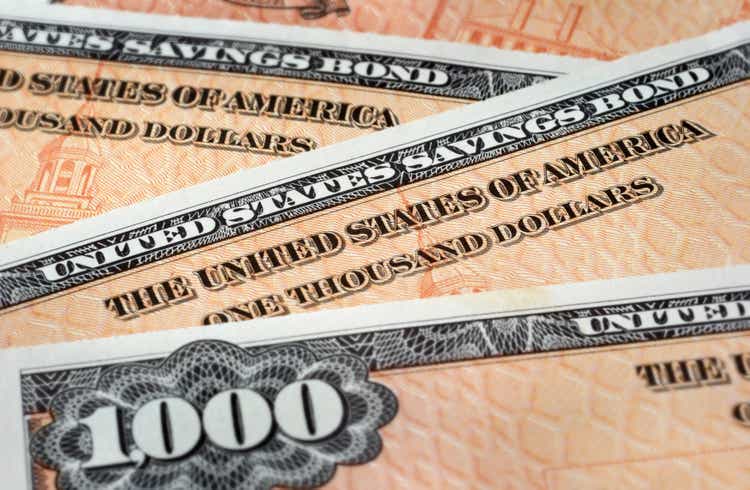Do Series Us Savings Bonds Continue to Earn Interest After Maturity
When savings bonds mature depends on the series of bond held. The maturity period for Series I and EE bonds is 30 years, while Series HH bonds mature after 20 years.

richcano/E+ via Getty Images
How Long Does It Take For Savings Bonds To Mature?
Savings bonds have two maturity periods: an original period and a final period. The original period is when the bond reaches its face value, while the final period is when the bond reaches its maximum value.
For example, a Series EE government bond has an original maturity period of 20 years but will still earn interest until the 30-year mark. After that, it doesn't earn interest anymore. However, the value of the bond at the 30-year mark is higher than the face value of the bond reached at 20 years.
Bond Original Maturity Period Final Maturity Period Series I 20 Years 30 Years Series EE 20 Years 30 Years Series HH 10 Years 20 Years
Series I Savings Bond Maturation
Series I Savings Bonds are those noted to fight the effects of inflation. It is a non-marketable, interest-bearing bond issued by the U.S. government. It earns a composite rate which means it has both a fixed and variable component. The variable component is indexed to inflation. Series I Savings Bonds continue to earn interest for 30 years with an original maturity date of 20 years.
Series EE Maturity
Series EE Savings Bonds are low-risk, interest-bearing bonds that have an original maturity date of up to 20 years with a final maturity date of 30 years. These bonds are guaranteed to double in value no later than 20 years after their issue date. When the bond doubles, it is said to have matured. See the section below to learn the maturity dates for different bonds issued at different interest rate terms.
Series HH Maturity
A Series HH Savings Bond is a low-risk bond with an original maturity date of 10 years. In this time, the interest rate is fixed. After the 10 years, the bond resets interest semi-annually and pays it until the bond reaches final maturity at 20 years.
Series EE Bond Maturity Dates
When you buy bonds, it's good to know when they will mature. Here are some examples of maturity dates of bonds issued at different times over the past four decades. These are listed as examples and not an end-all list of maturity dates.
Issue Dates Maturation January 1980 through October 1980 11 Years November 1980 through April 1981 9 Years May 1981 through October 1982 8 Years November 1982 through October 1986 10 Years November 1986 through February 1993 12 Years March 1993 through April 1995 18 Years
Compounded Interest
Savings bonds compound interest semi-annually. This means that the interest is added to the principal amount twice a year. When it is added, the new amount (principal plus interest) is used to determine the next amount of interest added. In other words, your interest earns interest.
Savings Bond Growth-To-Maturity Example
A Series EE Savings Bond purchased in February 1992 for $50 would have a value of $103.68 at final maturity of 30 years. After February 2022, the bond no longer earns interest.
Tip: Use the TreasuryDirect calculator to determine the value of existing savings bonds. It's easy to use as it only requests the type of bond you have, the denomination of the bond, and the issue date. You can enter the bond serial number if you have it for more accurate details.
What Happens When A U.S. Bond Matures?
What happens when a U.S. Savings Bond matures depends on what maturity you consider? When the original maturity is reached, the bond should be at least double what it was purchased for. At original maturity, the bond will continue to earn interest for another 10 years. At the end of 10 years, the bond is said to be at final maturity. At final maturity, the bond no longer earns interest, though you don't need to cash it in immediately.
To cash the bond in, you can go to a local bank that sells and redeems savings bonds or follow the instructions at TreasuryDirect.com.
Tip: Talk to a tax adviser when cashing in savings bonds. You may be subject to taxes if the bond is not used entirely for educational purposes.
How Long Should You Hold A Bond?
Holding a bond until original maturity ensures that the bond value will be the face value of the bond. You can hold it until final maturity to get more interest. Keep in mind that you cannot redeem a bond that was purchased within the last year. Also, if you cash it in prior to five years, you lose three months of interest. The answer depends on a variety of components so it's best to do your own research or discuss it with a financial advisor.
Disclosure: I/we have no stock, option or similar derivative position in any of the companies mentioned, and no plans to initiate any such positions within the next 72 hours. I wrote this article myself, and it expresses my own opinions. I am not receiving compensation for it. I have no business relationship with any company whose stock is mentioned in this article.
Source: https://seekingalpha.com/article/4502014-savings-bond-maturity
0 Response to "Do Series Us Savings Bonds Continue to Earn Interest After Maturity"
Post a Comment